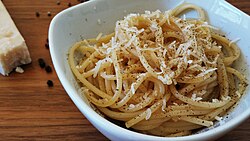Cacio e pepe
 | |
| Course | Primo (Italian pasta course) |
|---|---|
| Place of origin | Italy |
| Region or state | Lazio |
| Main ingredients | Tonnarelli or spaghetti, pecorino romano, black pepper |
Cacio e pepe (Italian: [ˈkaːtʃo e pˈpeːpe]) is a pasta dish typical of the Lazio region of Italy.[1][2] Cacio e pepe means 'cheese and pepper' in several central Italian dialects. The dish contains grated pecorino romano and black pepper with tonnarelli[3] or spaghetti.[2] The origins are believed to be that shepherds from the pastoral communities of Lazio, Abruzzo, Tuscany, and Umbria created cacio e pepe in the 18th or 19th century.[4] All the ingredients keep well for a long time, which made the dish practical for shepherds without a fixed abode.
Preparation
[edit]
The pasta is prepared in boiling salted water as usual; it is then poured into the grated pecorino mixed with black pepper, with a little of the hot, starchy, cooking water. The heat melts the cheese, and the starches in the water help bind the pepper and cheese to the pasta.[5]
See also
[edit]![]() Media related to Cacio e pepe at Wikimedia Commons
Media related to Cacio e pepe at Wikimedia Commons
References
[edit]- ^ "Cacio e Pepe Spaghetti". La Cucina Italiana. 5 July 2021. Retrieved 18 June 2024.
- ^ a b Boni (1930), p. 46
- ^ "Pasta cacio e pepe". Archived from the original on 24 March 2018. Retrieved 3 May 2018.
- ^ Jenn Harris (18 August 2021). "What is cacio e pepe and how did it take over the world?". News Tribune.
- ^ "Spaghetti Cacio e Pepe Ricetta Originale Romana" [Spaghetti cacio e pepe – the original Roman recipe]. The Foodellers (in Italian). Retrieved 17 October 2019. There is an English translation, but it lacks important tips on getting this deceptively simple dish right. Google Translate works well.
Bibliography
[edit]- Zanini De Vita, Oretta; Fant, Maureen B. (2013). Sauces & Shapes: Pasta the Italian Way. New York: W. W. Norton & Company. ISBN 978-0-393-08243-2.
- Boni, Ada (1983) [1930]. La Cucina Romana (in Italian). Roma: Newton Compton Editori. ISBN 978-8854117815.
